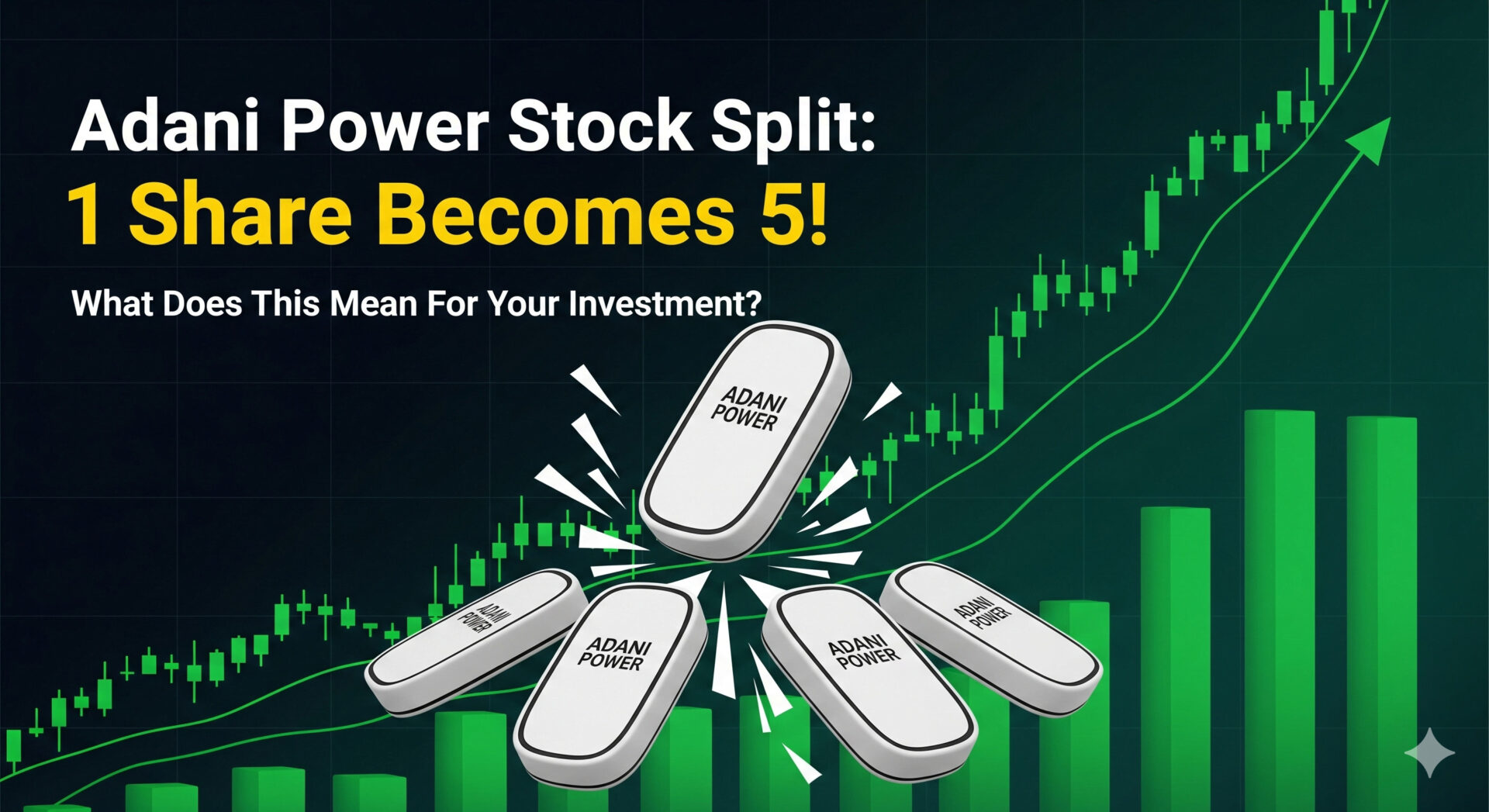Adani Power, one of India’s leading private-sector power producers, has announced its first-ever stock split, a significant corporate action aimed at enhancing liquidity and attracting retail investors. The company’s shareholders approved a 1:5 stock split on September 5, 2025, through a postal ballot issued on August 1, 2025. This move is set to make Adani Power shares more affordable, boosting participation from smaller investors. Here’s everything you need to know about the Adani Power stock split, its implications, and key dates.
Table of Contents
Adani Power Stock Split: Key Details
The stock split, approved by the board on August 1, 2025, will subdivide each equity share with a face value of ₹10 into five fully paid-up equity shares of ₹2 each. This 1:5 ratio means that for every share held, shareholders will receive five shares post-split, with the total value of their investment remaining unchanged. The split will increase the number of outstanding equity shares from 2,480 crore to 12,400 crore, while the company’s overall share capital remains the same.
The record date for the stock split is set for September 22, 2025, as announced by Adani Power. Shareholders holding shares as of this date will be eligible for the split. The company emphasized that this action aims to improve liquidity and make shares more accessible to retail investors by lowering the per-share price.
Why Is Adani Power Splitting Its Stock?
Adani Power, incorporated in 1996 and listed on the BSE and NSE in 2009, has seen significant growth in its business and share price over the years. The company operates an installed thermal power capacity of 18,110 MW, with plans to expand to 30,670 MW by 2030 through brownfield and greenfield projects. The stock split is a strategic move to:
- Enhance Liquidity: By increasing the number of shares and reducing the price per share, the split makes trading more accessible, potentially increasing market activity.
- Attract Retail Investors: A lower share price encourages participation from smaller investors, broadening the investor base.
- Support Growth Strategy: The split aligns with Adani Power’s expansion plans, including a $3.7 billion contract to build two coal-powered plants, reinforcing its position in India’s energy sector.
This is the first time Adani Power has undertaken a stock split, marking a historic corporate action for the company, which has not previously issued bonus shares or conducted splits.
Stock Split Impact on Shareholders
The 1:5 stock split will not alter the overall value of shareholders’ investments but will increase the number of shares they hold.
For example, if an investor owns 100 shares at ₹600 each (total value ₹60,000), post-split, they will hold 500 shares at approximately ₹120 each, maintaining the same total value of ₹60,000. This makes the stock more affordable for new investors without affecting the company’s market capitalization.
However, investors should note that stock splits do not inherently change a company’s fundamentals. Adani Power’s recent financial performance showed a 15.5% year-on-year decline in net profit to ₹3,305 crore for Q1 FY26, attributed to lower merchant tariffs and higher operating expenses. Despite this, the company reported a 1.6% increase in power sales volume to 24.6 billion units, reflecting operational resilience.
Adani Power Share Price Performance

On September 5, 2025, when the stock split approval was announced, Adani Power shares closed at approximately ₹603.65 on the BSE, down 0.80% from the previous session. The stock has experienced mixed performance, with a 6% decline over the past year but a 15% gain year-to-date in 2025, outperforming the Sensex’s 2% rise. The stock hit a 52-week high of ₹681.30 on September 16, 2024, and a low of ₹430.85 on November 21, 2024. Over the past five years, Adani Power has delivered stellar returns, surging over 1,038.5% from ₹49.80 in 2020 to ₹567 in August 2025, with a CAGR of 62.17%.
What Investors Should Know
The stock split is expected to enhance Adani Power’s market accessibility, but investors should consider both opportunities and risks:
- Opportunities: The lower share price may attract new investors, potentially driving demand and liquidity. Adani Power’s expansion plans and strategic acquisitions, such as the 600 MW VIPL coal power plant for ₹4,000 crore, signal long-term growth potential.
- Risks: The company faces challenges, including a high debt-to-equity ratio of 0.71 and controversies surrounding its 1,600 MW Godda plant in Bangladesh, which has faced tariff disputes and unpaid dues. Additionally, Adani Power does not pay dividends, which may deter income-focused investors.
Investors are advised to conduct thorough research and consult financial advisors before making investment decisions, as stock market investments carry inherent risks.
Key Dates to Watch
- Record Date: September 22, 2025 – Shareholders must hold shares by this date to be eligible for the split.
- Implementation: The split will take effect after regulatory approvals and procedural formalities, with new shares credited to shareholders’ demat accounts post-record date.
Conclusion
Adani Power’s 1:5 stock split marks a pivotal moment for the company, aimed at boosting retail investor participation and liquidity. As the largest private thermal power producer in India, with ambitious expansion plans, Adani Power remains a key player in the energy sector.
However, investors should weigh the company’s growth prospects against its financial and regulatory challenges before investing. Stay updated with the latest market news and consult with financial experts to make informed decisions.
Disclaimer: This article is for informational purposes only and does not constitute investment advice. Always conduct your own research and consult a qualified financial advisor before investing in the stock market.
Frequently Asked Questions (FAQs) About Adani Power Stock Split 2025
What is the Adani Power stock split ratio?
Adani Power has announced a 1:5 stock split, meaning each existing share with a face value of ₹10 will be subdivided into five shares with a face value of ₹2 each.
When is the record date for the Adani Power stock split?
The record date for the stock split is September 22, 2025. Shareholders holding shares as of this date will be eligible for the split.
Will the stock split affect the total value of my investment?
No, the total value of your investment will remain the same. For example, if you own 100 shares at ₹600 each (₹60,000), post-split, you will own 500 shares at approximately ₹120 each, maintaining the same value.
Why is Adani Power conducting a stock split?
The company aims to enhance liquidity, make shares more affordable for retail investors, and broaden its investor base, supporting its long-term growth strategy.
How will the stock split impact Adani Power’s share price?
The share price will decrease proportionally after the split (e.g., from ₹600 to approximately ₹120), but this does not reflect a change in the company’s overall market capitalization.
Do I need to take any action to receive the new shares?
No action is required from shareholders. The new shares will be credited automatically to your demat account after the split is implemented post the record date.
What are the risks associated with investing in Adani Power post-split?
Risks include a high debt-to-equity ratio, regulatory challenges (e.g., Godda plant disputes), and recent financial performance dips, such as a 15.5% decline in Q1 FY26 net profit.
When will the new shares be credited to my account?
The new shares will be credited after regulatory approvals and procedural formalities are completed, following the record date of September 22, 2025.
Disclaimer: This article is for informational purposes only and does not constitute investment advice. Please consult a financial advisor before making any investment decisions.









